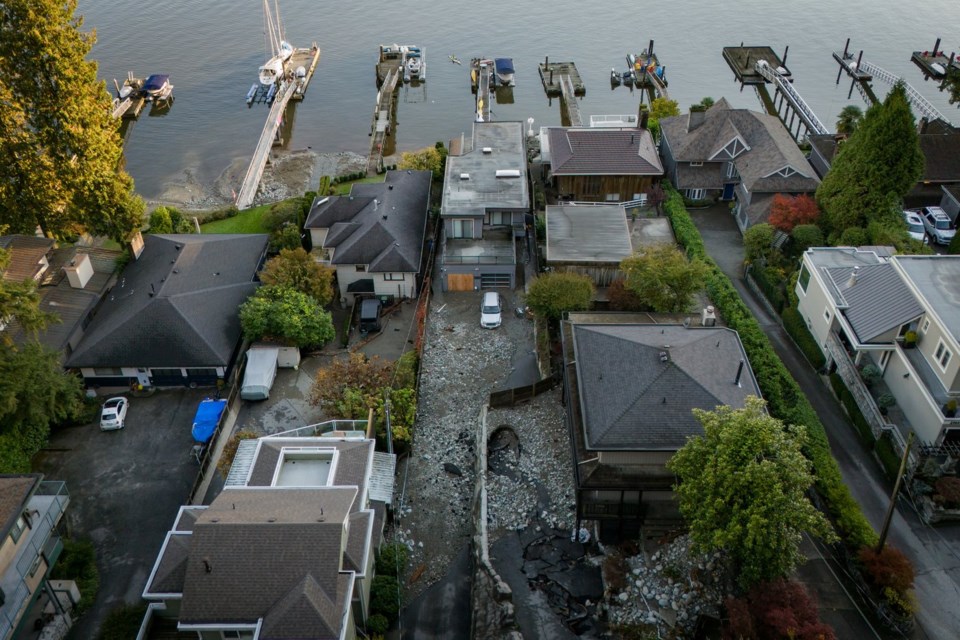NORTH VANCOUVER, B.C. — Heavy rain isn't unusual for the community of Deep Cove in North 91原创, but when Ashifa Saferali saw an e-bike floating down the middle of the street she knew this storm was something different.
Saferali is the owner of Honey Doughnuts and Goodies, a fixture in the community where she has lived and worked for almost three decades.
She's been through flash floods in the area before, but nothing like the torrent on Oct. 19, the day of B.C.'s provincial election.
“There is a creek up the road from us and I don’t know if that creek was backed up with leaves or debris, but it was coming down really fast, and within an hour, the flow of the water was just gushing down the hill and going straight down,” said Saferali, “It was pretty crazy.”
By the time it was over, 350 millimetres of rain had fallen in North 91原创, turning streets into rivers that plowed through waterfront homes, piling up boulders and gravel, and triggering a local state of emergency. The district told residents in six homes along the waterfront that they needed to evacuate.
The deluge is an example of how municipal infrastructure is struggling to keep up with demands of a fast-changing climate, as the frequency of extreme events escalates, and their severity worsens.
Engineers who once looked back at history to plan safeguards instead must look into the future, said Shahria Alam, a professor of civil engineering at the University of British Columbia Okanagan campus.
He gave the example of municipal engineers designing a stormwater drainage system, who might look at rainfall stretching back 50 years.
But weather patterns are changing fast.
"Which means that the system that you have designed will not be able to accommodate such huge additional water, and then, of course, your system will fail and disaster takes place," said Alam.
"Unfortunately, these kinds of incidents will keep happening because of climate change."
Some communities are aware of the challenges and preparing for it.
The City of 91原创 says in its climate change adaptation strategy that by the 2050s, average fall rainfall is expected to increase by 12 per cent.
But more worrying from an infrastructure perspective is the increasing prevalence and severity of "extreme rainfall events." It says rainfall so severe it would have occurred only once every 20 years, from 1981-2010, will occur twice as often by the 2050s.
The average amount falling in a single day during such an event will increase 20 per cent to 86 millimetres, it says.
The city says it will prepare by studying steep slopes that are at risk of instability, and managing rainwater to better allow it to be filtered and stored.
But even cities that have been diligently upgrading infrastructure over the years can see their drainage systems overwhelmed.
District of North 91原创 Mayor Mike Little said the city had spent millions upgrading infrastructure, including the Gallant Creek catch basin system in Deep Cove that had experienced many heavy rainfalls over the past ten years.
But the Oct. 19 storm was so intense it paralyzed the system by clogging it with massive amounts of debris.
Little recalled watching city crews use a backhoe that day as they tried to clear the catch basin on the steep Gallant Avenue, pulling out “six- to eight-foot-long woody debris."
“Even though it had been cleared ahead of time, there was just so much coming down that it still locked,” said Little, whose own basement was flooded.
Honey Doughnuts is on Gallant Avenue.
“You could not even walk. If you crossed, the water would be at your knees,” said owner Saferali.
Across the street, the manager of the Deep Cove Collective gift shop, Heather Radant, said she was left soaking wet as she fought vainly to keep the rising waters out, barricading the store with plywood, sandwich boards, and sandbags provided by city staff and neighbours.
She said the scene as the store flooded was "wild."
“I was thinking 'man, how do I just stay here and keep trying to keep the drains clear? How long is the water going to keep coming?' I didn't even know,” said Radant.
Alam said the ideal answer, long term, is not more concrete infrastructure.
He pointed instead to "climate-resilient" solutions, such as rainwater harvesting and installing "green roofs" on buildings, covered in plants and soil, to accumulate and retain moisture.
New stormwater-handling technology known as continuous deflective separation could better screen debris and sediment from run-off water, said Alam.
But solutions can be pricey.
“I have seen in many places, they are working hard and doing upgrades. But not all cities have those kinds of resources and many cities are struggling to keep up," said Alam.
Back in Deep Cove, Honey Doughnuts is bustling again, with a line out the door on a recent afternoon.
Across the street, Deep Cove Collective had reopened, thanks in part to customers and neighbours who dropped off dehumidifiers and fans to dry out the store.
"And this is one thing I love about being in this community — everyone comes together and helps everyone out," said Saferali.
This report by The 91原创 Press was first published Month Date, 2024.
Nono Shen, The 91原创 Press



